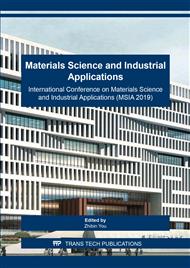[1]
IRSG, Statistical summary of world rubber situation, July-September 2018 edition on http://www.rubberstudy.com/statistics.aspx.
Google Scholar
[2]
S. Montes and J. L. White, A Comparative Rheological Investigation of Natural and Synthetic cis-1,4 Polyisoprenes and Their Carbon Black Compounds, Rubber Chem. Technol. 55 (1982) 1354-1369.
DOI: 10.5254/1.3535934
Google Scholar
[3]
L. Vaysse, F. Bonfils, J. Sainte-Beuve and M. Cartault, Natural Rubber. In: Matyjaszewski K and Möller M (eds.) Polymer Science: A Comprehensive Reference, Elsevier BV, Amsterdam, 2012, pp.281-293.
DOI: 10.1016/b978-0-444-53349-4.00267-3
Google Scholar
[4]
S. Rolere, C. Cazevieille, J. Sainte-Beuve and F. Bonfils, New insights on Natural Rubber microgel structure thanks to a new method for microaggregates extraction, Eur. Polym. J. 80 (2016) 117-125.
DOI: 10.1016/j.eurpolymj.2016.05.008
Google Scholar
[5]
S. Gan, Storage Hardening of Natural Rubber, J. Macromol. Sci. A. 33 (2006) 1939-1948.
Google Scholar
[6]
L. Bateman, chemistry and physics of rubber-like substances, Maclaren, Wiley, New York 1963, p.168.
Google Scholar
[7]
D. R. Burfield, Epoxy groups responsible for crosslinking in natural rubber, Nature. 249 (1974) 29-30.
DOI: 10.1038/249029a0
Google Scholar
[8]
D. R. Burfield and S. N. Gan, Nonoxidative crosslinking reactions in natural rubber. I. Determination of crosslinking groups, J. Polym. Sci. Polym. Chem. 13 (1975) 2725-2734.
DOI: 10.1002/pol.1975.170131207
Google Scholar
[9]
F. Ngolemasango, E. Ehabe, C. Aymard, J. Sainte-Beuve, B. Nkouonkam and F. Bonfils, Role of short polyisoprene chains in storage hardening of natural rubber, Polym. Int. 52 (2003) 1365-1369.
DOI: 10.1002/pi.1225
Google Scholar
[10]
S. Amnuaypornsri, A. Nimpaiboon and J. Sakdapipanich, Role of Phospholipids and Proteins on Gel Formation and Physical Properties of NR During Accelerated Storage, Kgk-Kautschuk Gummi Kunststoffe. 62 (2009) 88-92.
Google Scholar
[11]
A. Nimpaiboon, M. Sriring and J. T. Sakdapipanich, Molecular structure and storage hardening of natural rubber: Insight into the reactions between hydroxylamine and phospholipids linked to natural rubber molecule, J. Appl. Polym. Sci. 133 (2016).
DOI: 10.1002/app.43753
Google Scholar
[12]
S. D. Li, H. P. Yu, Z. Peng and P. S. Li, Study on variation of structure and properties of natural rubber during accelerated storage, J. Appl. Polym. Sci. 70 (1998) 1779-1783.
DOI: 10.1002/(sici)1097-4628(19981128)70:9<1779::aid-app16>3.0.co;2-a
Google Scholar
[13]
L. Tarachiwin, J. Sakdapipanich, K. Ute, T. Kitayama, T. Bamba, E.-I. Fukusaki, A. Kobayashi and Y. Tanaka, Structural characterization of alpha-terminal group of natural rubber. 1. Decomposition of branch-points by lipase and phosphatase treatments, Biomacromolecules. 6 (2005) 1851-1857.
DOI: 10.1021/bm058003x
Google Scholar
[14]
S. Rolere, C. Bottier, L. Vaysse, J. Sainte-Beuve and F. Bonfils, Characterisation of macrogel composition from industrial natural rubber samples: Influence of proteins on the macrogel crosslink density, Express Polym. Lett. 10 (2016) 408-419.
DOI: 10.3144/expresspolymlett.2016.38
Google Scholar


